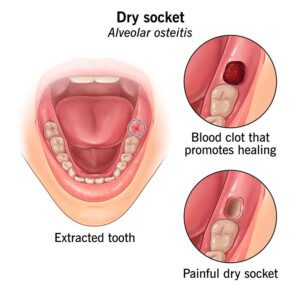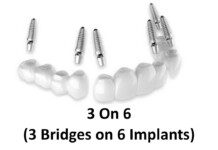
 Have you recently had a tooth extracted?
Have you recently had a tooth extracted?
One possible complication following a tooth extraction is a dry socket. They are very painful. They are relatively uncommon, occurring in only about 2-5% of routine tooth extractions, but are very painful, so you’ll want to be sure to avoid the known triggers. Understanding how to prevent a dry socket is crucial for a smooth healing experience.
What is a Dry Socket?
When a tooth is removed, a clot forms in the empty socket to protect the nerve underneath. A dry socket occurs when the blood clot becomes dislodged, exposing the underlying nerve to food debris and bacteria. This exposure leads to increased discomfort and can result in infection. Signs of infection include new or worsening pain and fever.
A dry socket, also known as alveolar osteitis, typically feels like a severe, throbbing pain at the site of the tooth extraction. This pain often radiates to the ear, eye, temple, or neck on the same side of the face. Unlike the normal discomfort that follows a tooth extraction, the pain from a dry socket usually begins a few days after the procedure and intensifies. The socket may also appear empty or have visible bone, and there may be an unpleasant taste or odor in the mouth.
A few interesting sidenotes: It happens more in lower teeth than uppers, is slightly more common in women than men (68%), and happens far more often in patients who smoke or have inadequate oral hygiene practices.
If you experience these symptoms, it’s important to contact your dentist promptly.
Common Causes of Dry Socket
- Smoking within 72 hours of surgery
- Poor oral hygiene
- Any sucking motion (like using a straw or sucking on mints)
- Eating hard or crunchy foods
- Pre-existing bacterial infection around the extracted tooth
- History of dry sockets
How to Prevent a Dry Socket
To lower your risk of developing a dry socket, follow these steps:
- Avoid Smoking After Surgery: Smoking can slow the healing process and dislodge the clot.
- Don’t Drink Out of a Straw: The suction from drinking through a straw can dislodge the clot.
- Don’t Suck Strongly and Spit: The instinctive desire to clear your mouth of this blood and saliva can make it tempting to suck and spit, as it feels like a natural way to manage oral hygiene and reduce the metallic taste associated with blood. However, it’s important to resist this urge to ensure proper healing. This sucking motion can dislodge the blood clot in the same way sucking on a straw does. Instead, if you need to spit, do so as gently as possible.
- Eat Soft Foods: Stick to soft foods like mashed potatoes, applesauce, or soup to avoid disrupting the clot. It’s best to do this for a few days following extractions.
- Follow Post-Surgery Instructions: Adhere strictly to your doctor’s post-operative guidelines for the best recovery.
Treating a Dry Socket
If you develop a dry socket, your dentist will clean the site and place a medicated dressing in the socket. If an infection is present, antibiotics may be prescribed. If you suspect a dry socket, contact your dentist immediately to schedule an appointment. Treatment for a dry socket typically begins to ease the pain within a few hours to a couple of days. Once a medicated dressing has been applied in the socket, patients often experience significant relief quickly. The dressing helps to protect the exposed bone and nerve, reducing pain and promoting healing. It’s essential to follow your dentist’s instructions and attend any follow-up appointments to ensure proper recovery.
If you have any questions or concerns following your extraction, don’t hesitate to give us a call. We’re here to support you throughout your healing journey.






